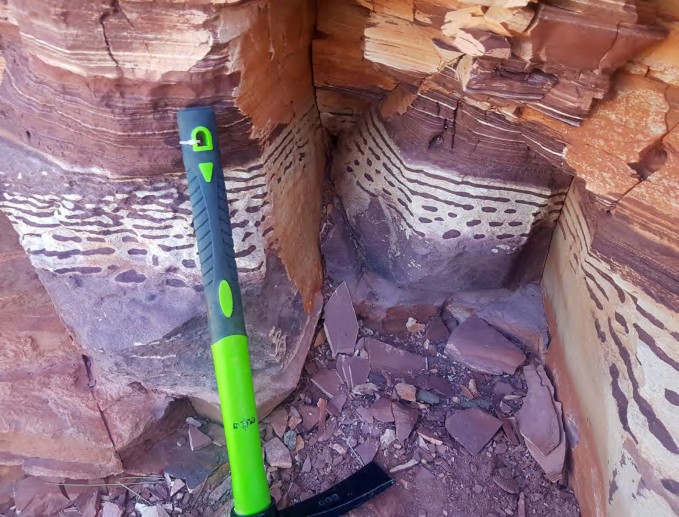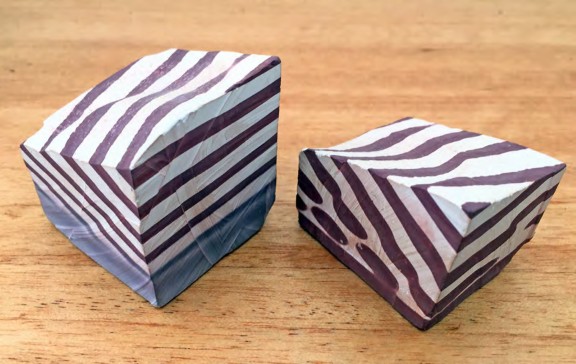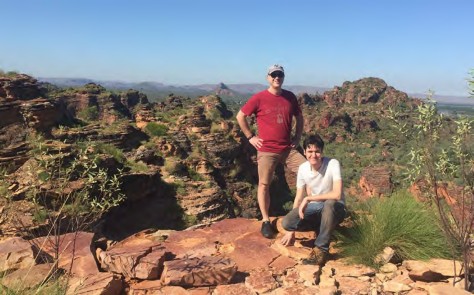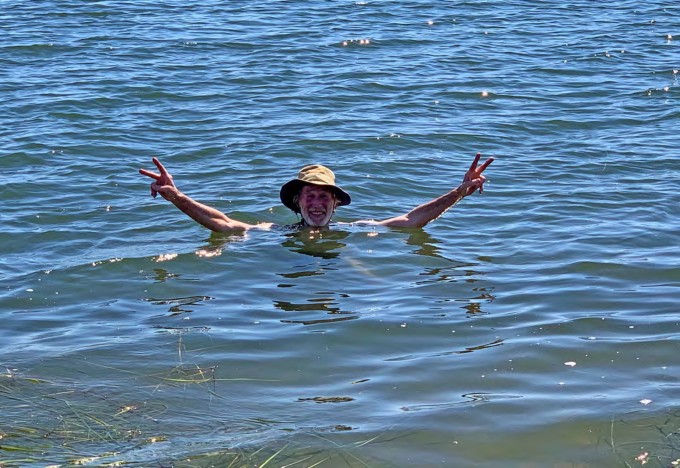

Author: Brad Pillans, Director, National Rock Garden
Extract from National Rock Garden Newsletter No. 22, December 2021
The NRG has a new logo, with the red and white stripes being inspired by the colour pattern of zebra rock, a rock which is only found in the Kununurra area of northern WA and nowhere else in the world. Zebra rock has strong claim to being Australia’s national rock and being represented in the National Rock Garden. Whether we will be able to acquire a suitable large specimen is rather uncertain because large blocks are rare. Needless to say, we remain hopeful…

Just how zebra rock forms remains something of a mystery, but regardless of how it forms, the precise combination of processes must be very rare. Otherwise it would be found in other places. The most similar rock, called print stone, is found near Mt Tom Price, in the Pilbara region of WA, but the colour banding is thinner and less regular than zebra rock.

At first sight, the red and white stripes of zebra rock look a lot like alternating sedimentary layers, and, indeed, this was the initial suggestion when it was first described in the 1920’s. However, closer inspection shows that some of the stripes cut across the sedimentary layers of the host rock, a claystone of Ediacaran age, called the Johnny Cake Shale. This means that the stripes formed after the sediment was deposited. A key question is whether the white stripes formed in a uniformly red rock or whether the red stripes formed in a uniformly white rock – a bit like asking whether zebras have black stripes on a white coat or white stripes on a black coat.
A number of other theories about the origin of zebra rock have been proposed, including:
- hydrothermal alteration by hot, percolating fluids
- Liesegang banding resulting from groundwater flow
- acid sulphate soil weathering
- precipitation from a colloidal suspension
- microbial activity.
Mineralogical investigations by Loughnan & Roberts (1990) showed that the claystone contains kaolinite, quartz, dickite (a polymorph of kaolinite), sericite (a type of mica), feldspar and alunite and that the red stripes are coloured by the iron oxide, hematite. The presence of dickite lends some support to a hydrothermal origin because dickite commonly, but not exclusively, forms by hydrothermal alteration. On the other hand, in a recent detailed study of zebra rock, published in the Australian Journal of Earth Sciences, Greg Retallack makes the case for an acid sulphate soil weathering origin (Retallack 2020).

There are some famous names along the road to discovering how zebra rock forms. For a start, there is the German chemist, Raphael Edward Liesegang (1869-1947), who was the first to systematically study the phenomenon of periodic (rhythmic) precipitation in gels, and after whom Liesegang rings or bands are named. Then there is the English mathematician and computer scientist, Alan Turing (1912-1954), who, among many great achievements (e.g. breaking the German Enigma Code during World War II), proposed a model of diffusion processes that results in patterns very similar to those seen in zebra rock (e.g. Kondo & Miura 2010).

My own contribution towards understanding the origin of zebra rock involves studying the paleomagnetism of the red stripes – when fine-grained hematite precipitates a magnetic signal is locked into the hematite in the direction of the Earth’s magnetic field. We can then use that signal to estimate when the hematite formed and place constraints on how long after deposition of the claystone the red stripes were formed. Also from laboratory measurements, we have been able to show that the rock has not been subject to heating above 300°C, which means that if hydrothermal fluids were involved, they must have been less than this – still pretty hot, though.

In June, this year, I visited Kununurra, with my ANU colleague, Professor Andrew Roberts, and PhD student, Andrew Coward, from Monash University, to collect more samples of zebra rock. The trip involved transiting through 5 states and territories (ACT, NSW, QLD, VIC, NT and WA) in the midst of variable COVID-19 restrictions. Remarkably, we managed to avoid any lockdowns and quarantining. I also had a swim in Lake Argyle (it was hot in Kununurra, even in June), which is inhabited by fresh-water crocodiles, and lived to tell the tale! There are reports that salt-water crocs occasionally make their way into Lake Argyle, but locals informed me that they don’t breed there – hmm…
By the time Andrew Coward completes his PhD thesis on zebra rock, perhaps we will finally know how it formed. No pressure, Andrew!

References
Kondo, S., Miura, T., 2010. Reaction-diffusion model as a framework for understanding biological pattern formation. Science, 329: 1616-1620. https://doi.org/10.1126/science.1179047
Loughnan, F.C., Roberts, F.I., 1990. Composition and origin of the ‘zebra rock’ from the East Kimberley region of Western Australia. Australian Journal of Earth Sciences, 37: 201-205. https://doi.org/10.1080/08120099008727920
Retallack, G.J., 2021. Zebra rock and other Ediacaran paleosols from Western Australia. Australian Journal of Earth Sciences, 68: 532-556. https://doi.org/10.1080/08120099.2020.1820574


